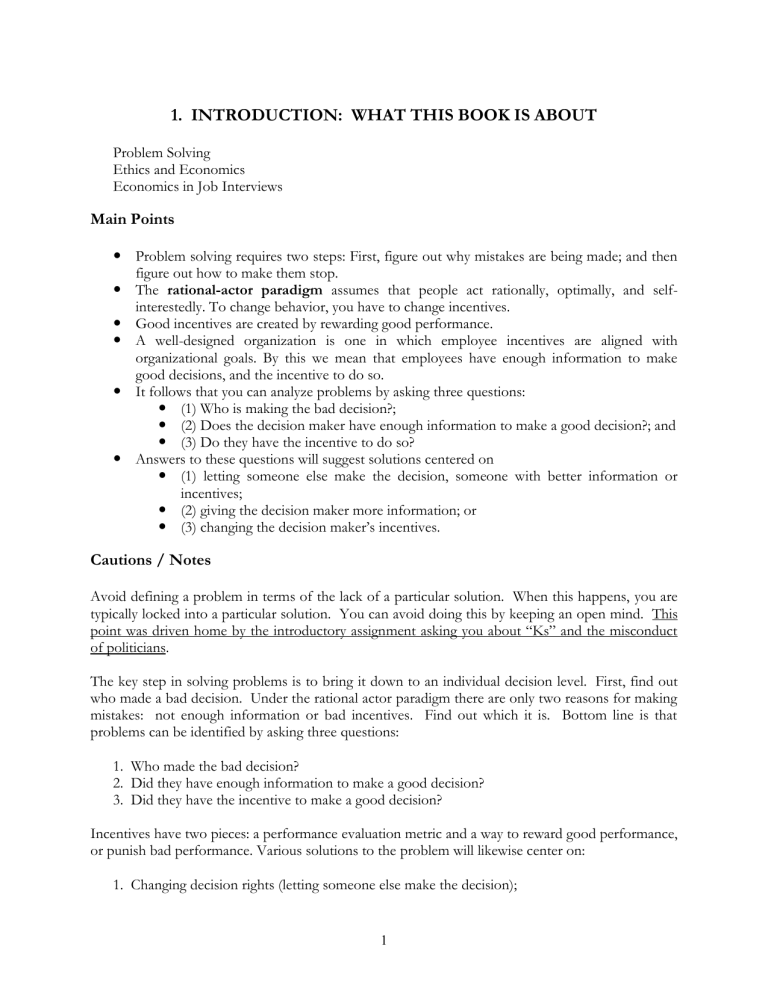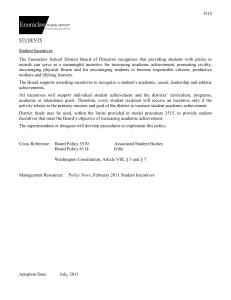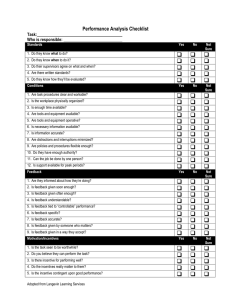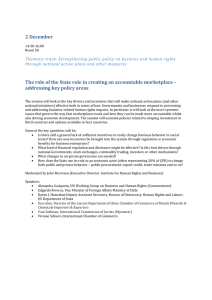
1. INTRODUCTION: WHAT THIS BOOK IS ABOUT Problem Solving Ethics and Economics Economics in Job Interviews Main Points Problem solving requires two steps: First, figure out why mistakes are being made; and then figure out how to make them stop. The rational-actor paradigm assumes that people act rationally, optimally, and selfinterestedly. To change behavior, you have to change incentives. Good incentives are created by rewarding good performance. A well-designed organization is one in which employee incentives are aligned with organizational goals. By this we mean that employees have enough information to make good decisions, and the incentive to do so. It follows that you can analyze problems by asking three questions: (1) Who is making the bad decision?; (2) Does the decision maker have enough information to make a good decision?; and (3) Do they have the incentive to do so? Answers to these questions will suggest solutions centered on (1) letting someone else make the decision, someone with better information or incentives; (2) giving the decision maker more information; or (3) changing the decision maker’s incentives. Cautions / Notes Avoid defining a problem in terms of the lack of a particular solution. When this happens, you are typically locked into a particular solution. You can avoid doing this by keeping an open mind. This point was driven home by the introductory assignment asking you about “Ks” and the misconduct of politicians. The key step in solving problems is to bring it down to an individual decision level. First, find out who made a bad decision. Under the rational actor paradigm there are only two reasons for making mistakes: not enough information or bad incentives. Find out which it is. Bottom line is that problems can be identified by asking three questions: 1. Who made the bad decision? 2. Did they have enough information to make a good decision? 3. Did they have the incentive to make a good decision? Incentives have two pieces: a performance evaluation metric and a way to reward good performance, or punish bad performance. Various solutions to the problem will likewise center on: 1. Changing decision rights (letting someone else make the decision); 1 2. Changing information flows; or 3. Changing incentives i. Performance evaluation ii. Compensation linking performance to rewards. The “goal” is to align the incentives of employees with the goals of the organization. The message is that there are only tradeoffs and no universal solutions, i.e., the answer to every question is “it depends.” The point of this class is to teach you to recognize and evaluate the tradeoffs. Sample Problem – answer is at bottom of page. Put yourself in the role of the newly hired manager. Identify the problem and how would you solve it? Goal Alignment at a Small Manufacturing Concern The owners of a small manufacturing concern have hired a manager to run the company with the expectation that he will buy the company after five years. Compensation of the new vice president is a flat salary plus 75% of first $150,000 of profit, and then 10% of profit over $150,000. Purchase price for the company is set as 4½ times earnings (profit), computed as average annual profitability over the next five years. Does this contract align the incentives of the new vice president with the goals of the owners? Supplementary Material – NOTE: Links to all of the following materials can also be found in the Other Video / Blog / Readings Links Tab Text Author’s Blog – Chapter 1 Blog Links Video – John Stossel’s Video “GREED,” by ABC News. (Part 1, Part 2, Part 3, Part 4, Part 5, Part 6). This is a provocative 45-minute video that covers several topics and gets students thinking about how people respond to incentives and how markets turn self-interested behavior by producers to the benefit of consumers. Part 3 has a nice comparison of a forprofit lifeguard company to the nonprofit Red Cross, and part 6 ends with a politically incorrect debate about whether Mother Theresa or Michael Milken did more for society. Milton Friedman v. Phil Donohue on Greed An Eloquent defense of capitalism by Uncle Milton. 2 Outsourced – “Buy American” decision has costs. Readings – Good very short story illustrating how markets turn self interest (greed) into group interest: Doti, Capitalism & Greed, This is a great very short story of two stores during a Chicago snow storm: one kept prices low and ran out of goods while the other doubled prices and was able to keep operating, even inducing kids to bring produce from the farmers markets on their sleds. Makes students think. Answer to sample problem: No. Both the purchase price and the profit sharing create perverse incentives. The VP keeps $0.75 of each dollar earned up to $150,000, but only $0.10 of each dollar earned after $150K. Since earning more requires more effort (increasing marginal effort), the VP has little incentive to earn more than $150,000. And every dollar the VP earns raises the price that he will eventually pay for the company by $4.50, effectively penalizing him for increasing company profitability. 3





